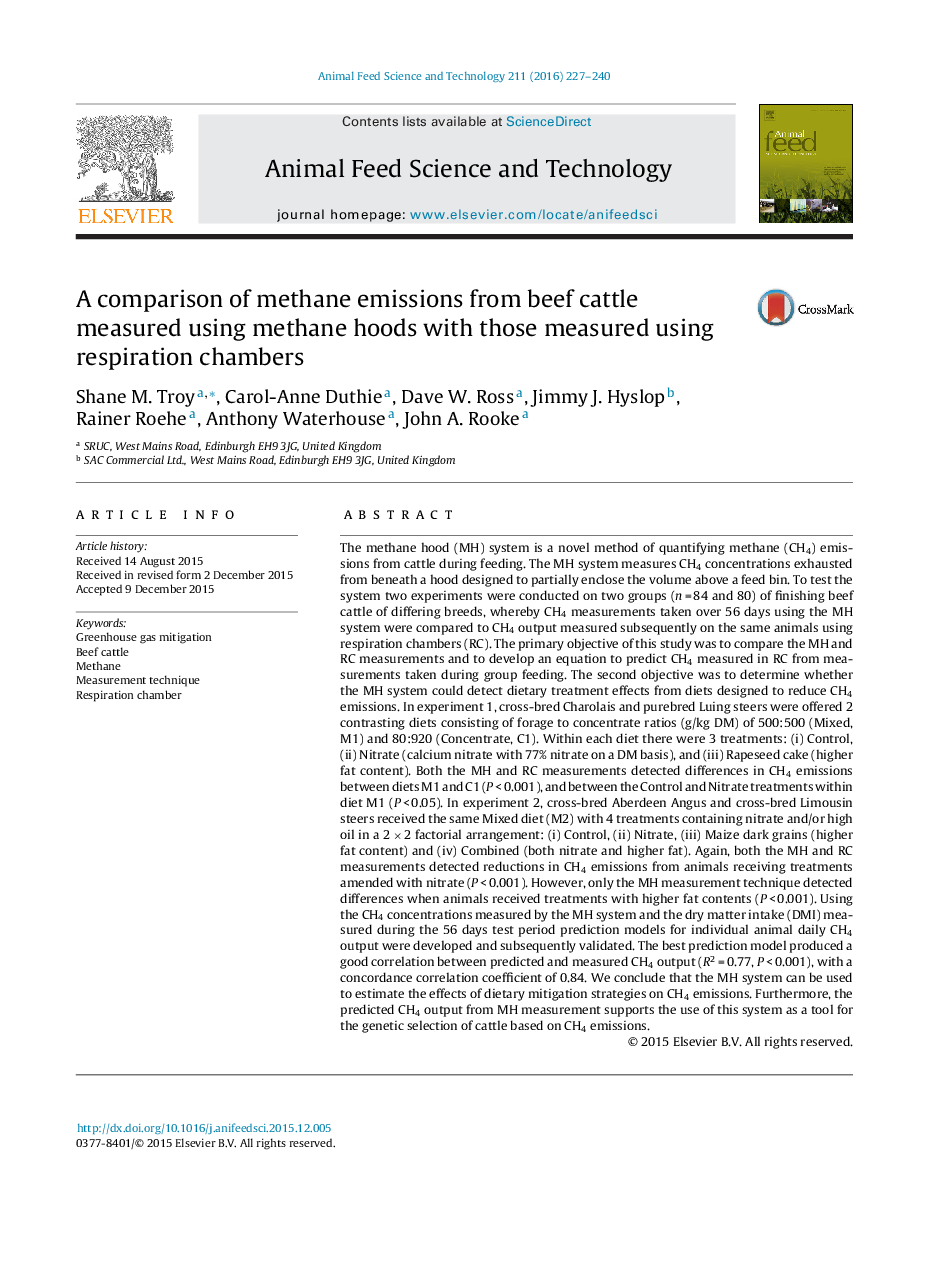| کد مقاله | کد نشریه | سال انتشار | مقاله انگلیسی | نسخه تمام متن |
|---|---|---|---|---|
| 8491342 | 1552374 | 2016 | 14 صفحه PDF | دانلود رایگان |
عنوان انگلیسی مقاله ISI
A comparison of methane emissions from beef cattle measured using methane hoods with those measured using respiration chambers
ترجمه فارسی عنوان
مقایسه میزان انتشار متان گاوهای گوشتی با استفاده از هود متان با اندازه گیری ها با استفاده از اتاق تنفس اندازه گیری شده است
دانلود مقاله + سفارش ترجمه
دانلود مقاله ISI انگلیسی
رایگان برای ایرانیان
کلمات کلیدی
موضوعات مرتبط
علوم زیستی و بیوفناوری
علوم کشاورزی و بیولوژیک
علوم دامی و جانورشناسی
چکیده انگلیسی
The methane hood (MH) system is a novel method of quantifying methane (CH4) emissions from cattle during feeding. The MH system measures CH4 concentrations exhausted from beneath a hood designed to partially enclose the volume above a feed bin. To test the system two experiments were conducted on two groups (n = 84 and 80) of finishing beef cattle of differing breeds, whereby CH4 measurements taken over 56 days using the MH system were compared to CH4 output measured subsequently on the same animals using respiration chambers (RC). The primary objective of this study was to compare the MH and RC measurements and to develop an equation to predict CH4 measured in RC from measurements taken during group feeding. The second objective was to determine whether the MH system could detect dietary treatment effects from diets designed to reduce CH4 emissions. In experiment 1, cross-bred Charolais and purebred Luing steers were offered 2 contrasting diets consisting of forage to concentrate ratios (g/kg DM) of 500:500 (Mixed, M1) and 80:920 (Concentrate, C1). Within each diet there were 3 treatments: (i) Control, (ii) Nitrate (calcium nitrate with 77% nitrate on a DM basis), and (iii) Rapeseed cake (higher fat content). Both the MH and RC measurements detected differences in CH4 emissions between diets M1 and C1 (P < 0.001), and between the Control and Nitrate treatments within diet M1 (P < 0.05). In experiment 2, cross-bred Aberdeen Angus and cross-bred Limousin steers received the same Mixed diet (M2) with 4 treatments containing nitrate and/or high oil in a 2 Ã 2 factorial arrangement: (i) Control, (ii) Nitrate, (iii) Maize dark grains (higher fat content) and (iv) Combined (both nitrate and higher fat). Again, both the MH and RC measurements detected reductions in CH4 emissions from animals receiving treatments amended with nitrate (P < 0.001). However, only the MH measurement technique detected differences when animals received treatments with higher fat contents (P < 0.001). Using the CH4 concentrations measured by the MH system and the dry matter intake (DMI) measured during the 56 days test period prediction models for individual animal daily CH4 output were developed and subsequently validated. The best prediction model produced a good correlation between predicted and measured CH4 output (R2 = 0.77, P < 0.001), with a concordance correlation coefficient of 0.84. We conclude that the MH system can be used to estimate the effects of dietary mitigation strategies on CH4 emissions. Furthermore, the predicted CH4 output from MH measurement supports the use of this system as a tool for the genetic selection of cattle based on CH4 emissions.
ناشر
Database: Elsevier - ScienceDirect (ساینس دایرکت)
Journal: Animal Feed Science and Technology - Volume 211, January 2016, Pages 227-240
Journal: Animal Feed Science and Technology - Volume 211, January 2016, Pages 227-240
نویسندگان
Shane M. Troy, Carol-Anne Duthie, Dave W. Ross, Jimmy J. Hyslop, Rainer Roehe, Anthony Waterhouse, John A. Rooke,
